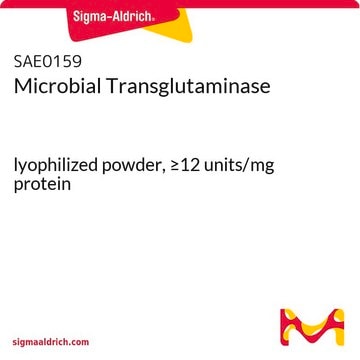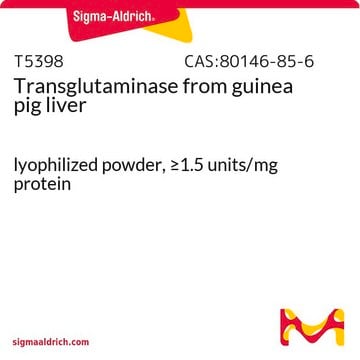C6154
Z-Gln-Gly
γ-glutamyl donor substrate
Synonym(s):
N2-[(phenylmethoxy)carbonyl]-L-glutaminyl-glycine
Sign Into View Organizational & Contract Pricing
All Photos(1)
About This Item
Empirical Formula (Hill Notation):
C15H19N3O6
CAS Number:
Molecular Weight:
337.33
MDL number:
UNSPSC Code:
12352209
PubChem Substance ID:
NACRES:
NA.26
Recommended Products
Quality Level
form
powder
storage temp.
−20°C
SMILES string
NC(=O)CCC(NC(=O)OCc1ccccc1)C(=O)NCC(O)=O
InChI
1S/C15H19N3O6/c16-12(19)7-6-11(14(22)17-8-13(20)21)18-15(23)24-9-10-4-2-1-3-5-10/h1-5,11H,6-9H2,(H2,16,19)(H,17,22)(H,18,23)(H,20,21)
InChI key
SOUXAAOTONMPRY-UHFFFAOYSA-N
Amino Acid Sequence
Z-Gln-Gly
Application
γ-Glutamyl donor substrate used in spectrophotometric determination of transglutaminase (TGase) activity. Z-Gln-Gly was used to enzymatically synthesize N-linked neoglycoproteins.
Biochem/physiol Actions
N-Benzyloxycarbonyl-L-Glutaminylglycine (Z-Gln-Gly, Z-QG) is used as a substrate to differentiate and characterize transglutaminase(s) (TGase) that catalyzes the post-translational covalent cross-linking of Gln- and Lys-containing peptides. Z-QG supports glutamyl-level cross-linking applications thruough surface modification.
Storage Class Code
11 - Combustible Solids
WGK
WGK 3
Flash Point(F)
Not applicable
Flash Point(C)
Not applicable
Personal Protective Equipment
dust mask type N95 (US), Eyeshields, Gloves
Choose from one of the most recent versions:
Already Own This Product?
Find documentation for the products that you have recently purchased in the Document Library.
Customers Also Viewed
Syeda Warisul Fatima et al.
Bioresource technology, 287, 121391-121391 (2019-05-12)
This work studied the production of Transglutaminase (TGase) using wheat bran as carbon source. The medium components and culture conditions were optimized by statistical Box-Behnken response surface methodology. The release of active Transglutaminase was enhanced by adding (i) protease to
Momoko Kitaoka et al.
Chemistry (Weinheim an der Bergstrasse, Germany), 17(19), 5387-5392 (2011-04-07)
A new synthetic strategy for DNA-enzyme conjugates with a novel architecture was explored using a natural cross-linking catalyst, microbial transglutaminase (MTG). A glutamine-donor substrate peptide of MTG was introduced at the 5-position on the pyrimidine of deoxyuridine triphosphate to prepare
Natalie M Rachel et al.
Protein science : a publication of the Protein Society, 26(11), 2268-2279 (2017-09-01)
Microbial transglutaminase (MTG) is a practical tool to enzymatically form isopeptide bonds between peptide or protein substrates. This natural approach to crosslinking the side-chains of reactive glutamine and lysine residues is solidly rooted in food and textile processing. More recently
Evan A Wells et al.
Archives of biochemistry and biophysics, 643, 57-61 (2018-02-27)
The Ca2+-dependent deamidation and transamidation activities of transglutaminase 2 (TG2) are important to numerous physiological and pathological processes. Herein, we have examined the steady-state kinetics and 15(V/K) kinetic isotope effects (KIEs) for the TG2-catalyzed deamidation and transamidation of N-Benzyloxycarbonyl-l-Glutaminylglycine (Z-Gln-Gly)
Gabe Javitt et al.
BMC biotechnology, 17(1), 23-23 (2017-03-02)
Microbial transglutaminase (mTG) is a robust enzyme catalyzing the formation of an isopeptide bond between glutamine and lysine residues. It has found use in food applications, pharmaceuticals, textiles, and biomedicine. Overexpression of soluble and active mTG in E. coli has
Our team of scientists has experience in all areas of research including Life Science, Material Science, Chemical Synthesis, Chromatography, Analytical and many others.
Contact Technical Service
















